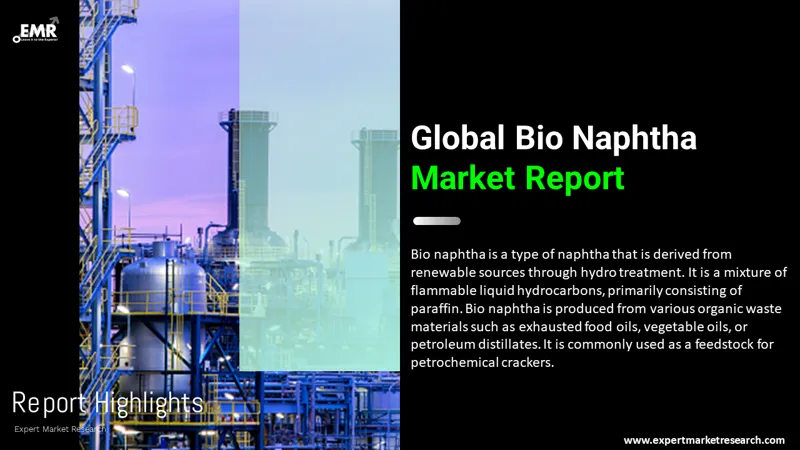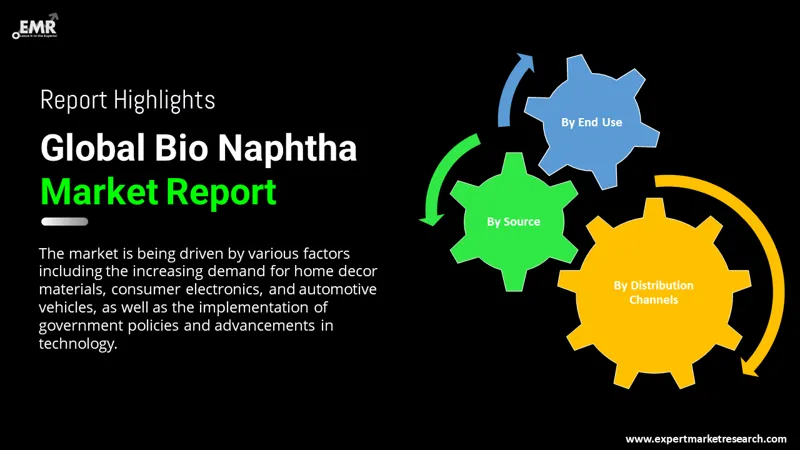
Consumer Insights
Uncover trends and behaviors shaping consumer choices today
Procurement Insights
Optimize your sourcing strategy with key market data
Industry Stats
Stay ahead with the latest trends and market analysis.
The global market size for bio naphtha reached an approximate size of 768.04 Thousand Tons by volume in 2025. The global bio naphtha market is expected to grow at a CAGR of 19.00% between 2026 and 2035, to reach a volume of 4373.74 Thousand Tons by 2035.
Base Year
Historical Period
Forecast Period
Compound Annual Growth Rate
19%
Value in Thousand Tons
2026-2035
*this image is indicative*
In September 2023, Keenan Recycling, a national food waste recycling business, unveiled its new hybrid vehicle at RWM & Letsrecycle Live in Birmingham. This vehicle replaces fossil diesel fuel with a mixture of hydrotreated vegetable oil (HVO) and hydrogen gas, resulting in a reduction in carbon dioxide emissions. This allows the company to draw further economic and environmental utilisation from food waste.
In February 2023, Honeywell UOP, using its Ecofining technology, that it jointly developed with Eni SpA, formulated a process for producing high yields of bio naphtha from bio based feedstock such as cooking oil and animal fats. It claims that this process reduces greenhouse gas and carbon dioxide emissions.
In December 2021, Mitsui Chemicals, a Japanese petrochemical producer, announced that it started producing 3000t of bio naphtha as its contribution to 2050 decarbonisation goal. It plans to combine bio naphtha with conventional naphtha to manufacture bio-petrochemical products, supplementing the global bio naphtha market.
In June 2021, Neste announced a long-term agreement with LyondellBasell, one of the world’s largest plastics and chemicals companies. Under the agreement, LyondellBasell would source Neste’s 100% renewable feedstock Neste RE™, made from bio-based sources. The feedstock would be processed by LyondellBasell in Germany to produce polymers under the brand CirculenRenew.
In January 2021, UPM BioFuels announced the expansion of its biofuel capabilities, starting the engineering phase of a next generation biorefinery. The new refinery is expected to have an annual production capacity of 500,000 tonnes, scaling up the capabilities of UPM BioFuels. The new biorefinery would introduce multiple sustainable feedstocks and lower CO2 emissions.

Read more about this report - REQUEST FREE SAMPLE COPY IN PDF
Naphtha is a flammable liquid hydrocarbon mixture, and bio naphtha refers to naphtha produced by the hydro treatment of the renewable sources. It consists of mainly paraffin and is obtained from exhausted food oils, vegetable oils, or any organic waste such as petroleum distillates. They are used as a feedstock for petrochemical crackers.
The EMR’s report titled “Bio Naphtha Market Report and Forecast 2026-2035” offers a detailed analysis of the market based on the following segments:
Market Breakup by Source
Market Breakup by End-Use
Market Breakup by Distribution Channels
Market Breakup by Region

Read more about this report - REQUEST FREE SAMPLE COPY IN PDF
Bio naphtha is a by-product of hydrogenated vegetable oil and sustainable aviation fuel. Due to the nature of hydrogenated vegetable oil technology it finds wide applications in conventional petroleum refineries. This technology can be easily adapted and used to produce conventional equipment and logistics for ships. It also has low capital costs due to high credit values. These plants are actively spread across North America, Europe and Asia and are slowly expanding in South America too, supporting the growth of the bio naphtha market.
Sustainable aviation fuel acts as a replacement for jet fuel. It is an essential contributing factor to the decarbonisation of the aviation industry. Although it’s still lacking in terms of legislative support from the world, European countries have already made it mandatory to blend sustainable aviation fuel for conventional jets.
The Asia Pacific has been leading the global bio naphtha market by region because of the rising consumption of plastic by the countries of the region and also due to rapid growth in end-user industries such as petrochemical, transportation and utilities. China, India and Japan are the major countries influencing the market in the Asia Pacific. Technological developments such as increase in chemical factories in China and rise in enhanced distillation methods is another factor influencing the market.
Moreover, Arab Gulf countries also play a major role in global biofuels supply by exporting a large volume of feedstock for bio naphtha, mainly as used cooking oil and hydrogenated vegetable oil. The steady feedstock supply is contributing in the progress of the bio naphtha market regionally and globally.
The comprehensive EMR report provides an in-depth assessment of the market based on Porter's five forces model along with giving a SWOT analysis. The report gives a detailed analysis of the following key players in the global bio naphtha market, covering their competitive landscape and latest developments.
Neste Oil is the world’s largest producer of renewable diesel and was established in 1948. It is an oil refining and marketing company located in Finland. It is the world’s first company to supply bio naphtha on a commercial scale. It concentrates on low-emission and high-quality traffic fuels for better functioning of society. NExBTL was launched by the company to produce bioplastics that can be beneficially used in various industries.
UPM Corporation was established in 2015 in Finland and has a strong presence in the bio naphtha market. Its products can be used in place of fossil-fuel raw materials in numerous innovative products such as plastics, glue, and films. UPM BioVerno is a key product line of the company. It assures to be 100% bio-based and offer products with similar properties to fossil-based naphtha.
Eni S.p.A, a global energy company, was founded in 1953 in Milan, Italy. They work to support changes that create long-term value and provide an opportunity for all to have access to dependable and clean energy. It focuses on issues such as decarbonisation while working to protect the environment. They believe to be getting closer to their goal of decarbonisation by 2040 by providing their clients with decarbonised products and services.
*Please note that this is only a partial list; the complete list of key players is available in the full report. Additionally, the list of key players can be customized to better suit your needs.*
Other market players include Total Energies SE, Royal Dutch Shell Plc, Sunshine Kaidi New Energy Group Co., Ltd., Preem AB, OMV Group, Repsol S.A., Phillips 66 and others.




*While we strive to always give you current and accurate information, the numbers depicted on the website are indicative and may differ from the actual numbers in the main report. At Expert Market Research, we aim to bring you the latest insights and trends in the market. Using our analyses and forecasts, stakeholders can understand the market dynamics, navigate challenges, and capitalize on opportunities to make data-driven strategic decisions.*
Get in touch with us for a customized solution tailored to your unique requirements and save upto 35%!
The global market size for bio naphtha was estimated to be 768.04 Thousand Tons by volume in 2025.
The expected market size is projected to reach an approximate volume of 4373.74 Thousand Tons by 2035.
The global market for bio naphtha is expected to grow at a CAGR of 19.00% between 2026 and 2035.
Naphtha is a flammable liquid hydrocarbon mixture. Bio naphtha refers to naphtha produced by the hydro-treatment of renewable sources.
The key drivers of the market are the rising demand for home decor materials, consumer electronics and automotive vehicles, implementation of government policies and technological advancements.
The market for bio naphtha is segmented on the basis of source, end use, distribution channels and regions.
Key market players include Neste Oil, UPM Corporation, Eni S.p.A., Total Energies SE, Royal Dutch Shell Plc, Sunshine Kaidi New Energy Group Co., Ltd., Preem AB, OMV Group, Repsol, S.A., and Phillips 66, among others.
Major regional markets for bio naphtha include North America, Europe, Asia Pacific, Latin America and the Middle East and Africa.
Bio naphtha consists of primarily paraffin.
Explore our key highlights of the report and gain a concise overview of key findings, trends, and actionable insights that will empower your strategic decisions.
| REPORT FEATURES | DETAILS |
| Base Year | 2025 |
| Historical Period | 2019-2025 |
| Forecast Period | 2026-2035 |
| Scope of the Report |
Historical and Forecast Trends, Industry Drivers and Constraints, Historical and Forecast Market Analysis by Segment:
|
| Breakup by Source |
|
| Breakup by End-Use |
|
| Breakup by Distribution Channels |
|
| Breakup by Region |
|
| Market Dynamics |
|
| Price Analysis |
|
| Competitive Landscape |
|
| Companies Covered |
|
Datasheet
One User
USD 2,999
USD 2,699
tax inclusive*
Single User License
One User
USD 4,839
USD 4,355
tax inclusive*
Five User License
Five User
USD 5,999
USD 5,099
tax inclusive*
Corporate License
Unlimited Users
USD 7,259
USD 6,170
tax inclusive*
*Please note that the prices mentioned below are starting prices for each bundle type. Kindly contact our team for further details.*
Flash Bundle
Small Business Bundle
Growth Bundle
Enterprise Bundle
*Please note that the prices mentioned below are starting prices for each bundle type. Kindly contact our team for further details.*
Flash Bundle
Number of Reports: 3
20%
tax inclusive*
Small Business Bundle
Number of Reports: 5
25%
tax inclusive*
Growth Bundle
Number of Reports: 8
30%
tax inclusive*
Enterprise Bundle
Number of Reports: 10
35%
tax inclusive*
How To Order

Select License Type
Choose the right license for your needs and access rights.

Click on ‘Buy Now’
Add the report to your cart with one click and proceed to register.

Select Mode of Payment
Choose a payment option for a secure checkout. You will be redirected accordingly.
Gain insights to stay ahead and seize opportunities.

Get insights & trends for a competitive edge.

Track prices with detailed trend reports.

Analyse trade data for supply chain insights.

Leverage cost reports for smart savings

Enhance supply chain with partnerships.

Connect For More Information
Our expert team of analysts will offer full support and resolve any queries regarding the report, before and after the purchase.
Our expert team of analysts will offer full support and resolve any queries regarding the report, before and after the purchase.
We employ meticulous research methods, blending advanced analytics and expert insights to deliver accurate, actionable industry intelligence, staying ahead of competitors.
Our skilled analysts offer unparalleled competitive advantage with detailed insights on current and emerging markets, ensuring your strategic edge.
We offer an in-depth yet simplified presentation of industry insights and analysis to meet your specific requirements effectively.
Share